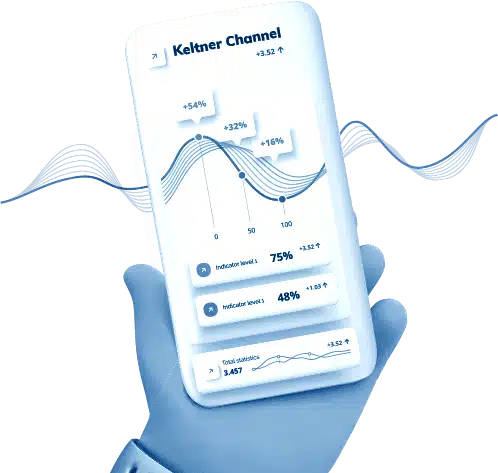Keltner Channel Indicator and Strategies

- What is Keltner Channel
- Mechanics and Calculation of Keltner Channel
- Reading the Keltner Channel
- Trading Keltner Channel Signals
- Best Strategies
- Trade with the Keltner Channel on the Friedberg Direct Platforms
The Keltner Channel is a volatility-based technical analysis indicator that helps in defining price trends as well as pinpointing overbought and oversold conditions in the market. Chester Keltner, a famous commodity trader, introduced the indicator in the 1960s, but the modern-day version (that includes the ATR, average true range) was updated by Linda Raschke in the 1980s.
The Keltner Channel is part of volatility-based envelope indicators. A comparable indicator is the popular Bollinger Bands. However, while both are volatility-based channels, there are some key differences. With Bollinger Bands, the width of the channel is determined by standard deviation, whereas the ATR is the determinant with Keltner Channels.
Functionally, this means that Bollinger Bands react faster to price changes, making it more prone to false signals during short-lived spikes. On the other hand, the Keltner Channel is more smoothed out and is able to provide definitive confluence signals.
Open your trading account at Friedberg Direct or try our risk-free demo account!
Mechanics and Calculation of Keltner Channel
The Keltner Channel indicator has 3 channel lines: middle line, upper line and lower line. The lines are calculated as follows:
Upper line = EMA + (ATR x multiplier)
Middle line = EMA
Lower line = EMA – (ATR x multiplier)
The EMA (exponential moving average) gives more weight to recent price changes than a simple moving average. All the above parameters can be adjusted according to the needs of individual traders.
The default EMA is the 20-day period: the longer the EMA, the more lagging the indicator will be; the shorter the EMA, the faster the indicator will react to price changes.
In addition, the default multiplier is 2: the bigger the multiplier, the wider the channel; the smaller the multiplier, the narrower the channel. The incorporation of the ATR ensures that the Keltner Channel is able to provide a comprehensive volatility picture of an underlying asset’s price.
Reading the Keltner Channel
The Keltner Channel delivers graphical price signals that can easily be deciphered by traders. The slope of the channel denotes the price trend in the market. A rising channel implies that an uptrend is in place; a falling channel indicates a downtrend; whereas a flat or sideways channel implies a ranging market.
In an uptrend, a momentous price surge will lead to a price continuously hitting the upper line, or even breaking it. When the channel is still rising but the price starts hitting the lower line, it is a signal that the uptrend is losing momentum.
This is the same with a falling channel. For a sideways channel, the upper line and lower line will act as resistance and support zones, respectively. When the channel is sideways, traders also watch out for potential price breakouts.
Trading Keltner Channel Signals
The Keltner Channel produces multiple signal types for traders. Here is how to effectively trade the signals:
- Trend Pullback Signals
The Keltner Channel delivers compelling signals in trending markets. As mentioned above, the slope of the channel will quickly indicate whether the trend is up or down. In an uptrend, prices will mostly ‘hug’ the upper line. Buy orders can then be placed when the price pulls back to the middle line. In a downtrend, prices will tread closer to the lower line, and traders can seek to join aggressively on the direction of the trend when prices retrace to the middle line.
- Overbought and Oversold Conditions
While a break of the upper or lower lines may signal a momentous trend, it is advisable to be wary of overbought or oversold conditions. An overbought signal will occur when the price breaks above the upper line but drifts lower to close inside the line as well. This implies that the price lacked enough momentum to sustain the upward surge and a tumble is possible. It will be a signal to seek opportunities to place sell orders.
On the other hand, an oversold signal will occur when the price breaks below the lower line but ends up closing inside the channel as the bearish pressure would not be sustained. This would be a signal to seek opportunities to place buy orders in the market.
- Breakout Signals
The Keltner Channel delivers powerful breakouts signals. As a lagging volatility-based indicator, breakout signals are definitive and more qualified. The incorporation of ATR ensures that the Keltner Channel is more effective when volatility rises, and as a lagging indicator, it also ensures that false signals are filtered out.
The best breakouts to trade are when the Keltner Channel is indicating a sideways trend. This implies low volatility in the market. When volatility rises, a breach of the upper line would indicate a bullish breakout; while a breach of the lower line would indicate a bearish breakout.
Traders can join a bullish breakout early when there is a pullback to the outside of the upper line. Likewise, when a bearish breakout occurs, traders can seek to place aggressive sell orders when the price pulls back to the outside of the lower line.
Best Keltner Channel Strategies
The Keltner Channel is a robust indicator, but it can be complemented by other indicators to provide definitive confluences. One of the best complimentary indicators is the ADX (average directional index), which will help qualify momentous trends and will help identify false breakouts.
In ranging markets, the strategy is to buy at support and sell at resistance. But to only trade high probability signals, traders can combine the Keltner Channel with oscillators, such as Stochastics and RSI, that deliver overbought and oversold signals.
Trade with the Keltner Channel on the Friedberg Direct Platform
Most MT4 and MT5 (MetaTrader) platforms do not have the powerful Keltner Channel built-in. The Keltner Channel is, however, available at Friedberg Direct, and here is why you should trade with this Canadian-regulated broker:
- Multiple Timeframes – The Keltner Channel can be applied on up to 21 chart timeframes which Friedberg Direct has available.
- Numerous Tools – The Keltner Channel is not a standalone indicator. Friedberg Direct has more than 200 other indicators available that can be paired up with the Keltner Channel to enhance asset price analyses.
- Demo Account – Friedberg Direct has a free demo account available, where traders can try out different Keltner Channel strategies without putting any money on the line.
Open your trading account at Friedberg Direct or try our risk-free demo account!
** Disclaimer – While due research has been undertaken to compile the above content, it remains an informational and educational piece only. None of the content provided constitutes any form of investment advice.







